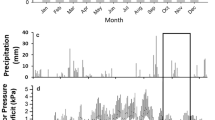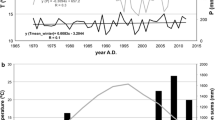Abstract
The stable C isotope composition (δ13C) of leaf and wood tissue has been used as an index of water availability at both the species and landscape level. However, the generality of this relationship across species has received little attention. We compiled literature data for a range of conifers and examined relationships among landscape and environmental variables (altitude, precipitation, evaporation) and δ13C. A significant component of the variation in δ13C was related to altitude (discrimination decreased with altitude in stemwood, 2.53‰ km–1 altitude, r 2=0.49, and in foliage, 1.91‰ km–1, r 2=0.42), as has been noted previously. The decrease in discrimination with altitude was such that the gradient in CO2 partial pressure into the leaf (P a–P i) and altitude were generally unrelated. The ratio of precipitation to evaporation (P/E) explained significant variation in P a–P i of stemwood (r 2=0.45) and foliage (r 2=0.27), but only at low (<0.8) P/E. At greater P/E there was little or no relationship, and other influences on δ13C probably dominated the effect of water availability. We also examined the relationship between plant drought stress (Ψ) and δ13C within annual rings of stemwood from Pinus radiata and Pinus pinaster in south-western Australia. Differential thinning and fertiliser application produced large differences in the availability of water, nutrients and light to individual trees. At a density of 750 stems ha–1, Ψ and δ13C were less (more negative) than at 250 stems ha–1 indicating greater drought stress and less efficient water use, contrary to what was expected in light of the general relationship between discrimination and P/E. The greater δ13C of trees from heavily thinned plots may well be related to an increased interception of radiation by individual trees and greater concentrations of nutrients in foliage – attributes that increase rates of photosynthesis, reduce P i and increase δ13C. δ13C was thus modified to a greater extent by interception of radiation and by nutrient concentrations than by water availability and the δ13C-Ψ relationship varied between thinning treatments. Within treatments, the relationship between δ13C and Ψ was strong (0.38<r 2<0.58). We conclude that δ13C may well be a useful indicator of water availability or drought stress, but only in seasonally dry climates (P/E<1) and where variation in other environmental factors can be accounted for.
Similar content being viewed by others
Author information
Authors and Affiliations
Additional information
Electronic Publication
Rights and permissions
About this article
Cite this article
Warren, C.R., McGrath, J.F. & Adams, M.A. Water availability and carbon isotope discrimination in conifers. Oecologia 127, 476–486 (2001). https://doi.org/10.1007/s004420000609
Received:
Accepted:
Published:
Issue Date:
DOI: https://doi.org/10.1007/s004420000609




